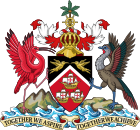
Back حزب العمال الديمقراطي (ترينيداد وتوباغو) Arabic Демократическая лейбористская партия (Тринидад и Тобаго) Russian
Democratic Labour Party | |
|---|---|
| Abbreviation | DLP |
| Leader |
Successor Factions
|
| Founder | 11 founders
|
| Founded | 1 September 1957[2] |
| Dissolved | DLP factions split into three parties in 1972 DLP's successor factions end in 1976 |
| Merger of | |
| Succeeded by | |
| Headquarters | Carlton Center, San Fernando, Trinidad and Tobago[3] |
| Labor wing | All Trinidad Sugar Estates and Factory Workers Union (de facto) |
| Ideology | Majority: Labourism Civic nationalism Anti-communism Indo-Trinidadian and Tobagonian civil rights Hindu and Muslim religious rights Left-wing Faction: Social liberalism Democratic socialism Right-wing Faction: Conservatism Anti-socialism[e][4] |
| Political position | Big tent (originally) Centre (with right- and left-wing factions) |
| Regional affiliation | West Indies Democratic Labour Party |
| Colors | Orange |
| Election symbol | |
| Flaming torch | |
| |
 |
|---|
|
|
The Democratic Labour Party (abbr. DLP) was the main opposition party in Trinidad and Tobago from 1957 till 1976. That party was the party which opposed the People's National Movement (PNM) at the time of Independence. After several splits brought about by leadership struggles, the party lost its hold on the Indo-Trinidadian community in the 1976 General Elections and was displaced in parliament by the United Labour Front under the leadership of Basdeo Panday, a former DLP senator. The party was the representative of the ethnic Indian community in the country; however Indian Muslims and Christians were said to be less loyal to the party than Indian Hindus.[5]
The party symbol was a flaming torch.
- ^ https://ufdcimages.uflib.ufl.edu/UF/00/09/78/64/00001/democraticlaborp00malirich.pdf [bare URL PDF]
- ^ https://ufdcimages.uflib.ufl.edu/UF/00/09/78/64/00001/democraticlaborp00malirich.pdf [bare URL PDF]
- ^ https://www.ebctt.com/wp-content/uploads/List-of-Political-Parties-and-their-respective-Symbols.pdf [bare URL PDF]
- ^ "The Democratic Labor Party of Trinidad: an attempt at the formation of a mass party in a multi-ethnic society" (PDF). University of Florida. Retrieved 29 June 2020.
- ^ Horowitz, Donald L. "Ethnic Groups in Conflict. Chapter 7.